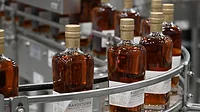High BOD Wastewater Handled at Beverage Destruct Facility Turns Waste to Value
 Food and beverage manufacturers periodically have to remove their out-of-spec product from either the market or from getting to the market to ensure quality and safety for their customers. When this happens, the manufacturers often employ the services of a full-goods certified destruct company.
Food and beverage manufacturers periodically have to remove their out-of-spec product from either the market or from getting to the market to ensure quality and safety for their customers. When this happens, the manufacturers often employ the services of a full-goods certified destruct company.
VIM Recyclers has been around for more than 20 years and operates in 30 states. It has a versatile product and packaging recycling facility near Chicago, IL. This facility handles a lot of beverage destruct work where it takes full product, crushes it and removes the fluid from the packaging. The aluminum and/or PET is then separated and recycled. Previously, the fluid was discharged from the contents of the beverage containers directly to the Fox Metro municipal wastewater treatment facility. This effluent, due to the nature of the beverage, typically has a sugar content of roughly 5 percent, which correlates to 50,000 ppm BOD (biological oxygen demand) and a pH of around three to four. This high-BOD effluent often caused operational challenges for the treatment facility in addition to the issuance of very high BOD monetary surcharges from Fox Metro.
The high-sugar effluent primarily receives either aerobic or anaerobic biological treatment, which requires high capital, land, building and operational resources. In this case, a similar treatment option would have an investment return of well over 10 years and require dedicated engineering and operational resources.
The recycler began to work with GE Power & Water to create a solution that would have a return of three years or less, in addition to minimal space and operational staff requirements. A four-in. spiral wound membrane pilot skid was put in the facility for one to two months. GE concluded a successful pilot study using nano-filtration and reverse osmosis (RO) membranes. The results were promising as the study revealed the membranes were capable of splitting the high-BOD effluent into a 25-percent sugar stream (20-30 brix) and a low-BOD permeate stream from the RO.
The feed stream is about two to six brix of concentration with a pH between three and three and a half. The resulting permeate water has a sugar concentration of <1 brix and a relatively low pH value after passing through the membrane with some of the citric acid. As a result, some caustic is added to the RO permeate water prior to discharge to the local municipality.
A full-scale unit was built and commissioned in 2007 and is still in operation. This machine creates around 25 gpm of permeate and five to seven gpm of concentrate, so it is operating at around 85-percent recovery. The low-fouling membrane technology and system design allows the elements to last up to two years, which is uncommon for this application. The system operates continuously in a once-through design with operating pressures up to 800 psi. The system is flushed with permeate water for short shutdown periods and cleaned with hot water CIPs (clean in place) when it is shut down for more than one day.
The process stream consisted of the following:
- The VIM extractor to separate and dewater the packaging
- Gravity screens
- 20,000-gallon atmospheric storage tank
- 25-micron bag filter
- 5-micron bag filter
- A process holding tank
- 1 micron cartridge filter
- Triple membrane system: RO, RO and NF system
This solution creates a high-BOD stream that has a multitude of uses, other than expensive discharge to the local POTW. For example, alternative uses for this high-sugar stream include conversion to ethanol, animal feed and polymerization into biodegradable plastics.
For more information: contact Hugh Miranzadeh, hugh.miranzadeh@ge.com, or visit the GE Power & Water web site.
Looking for a reprint of this article?
From high-res PDFs to custom plaques, order your copy today!






